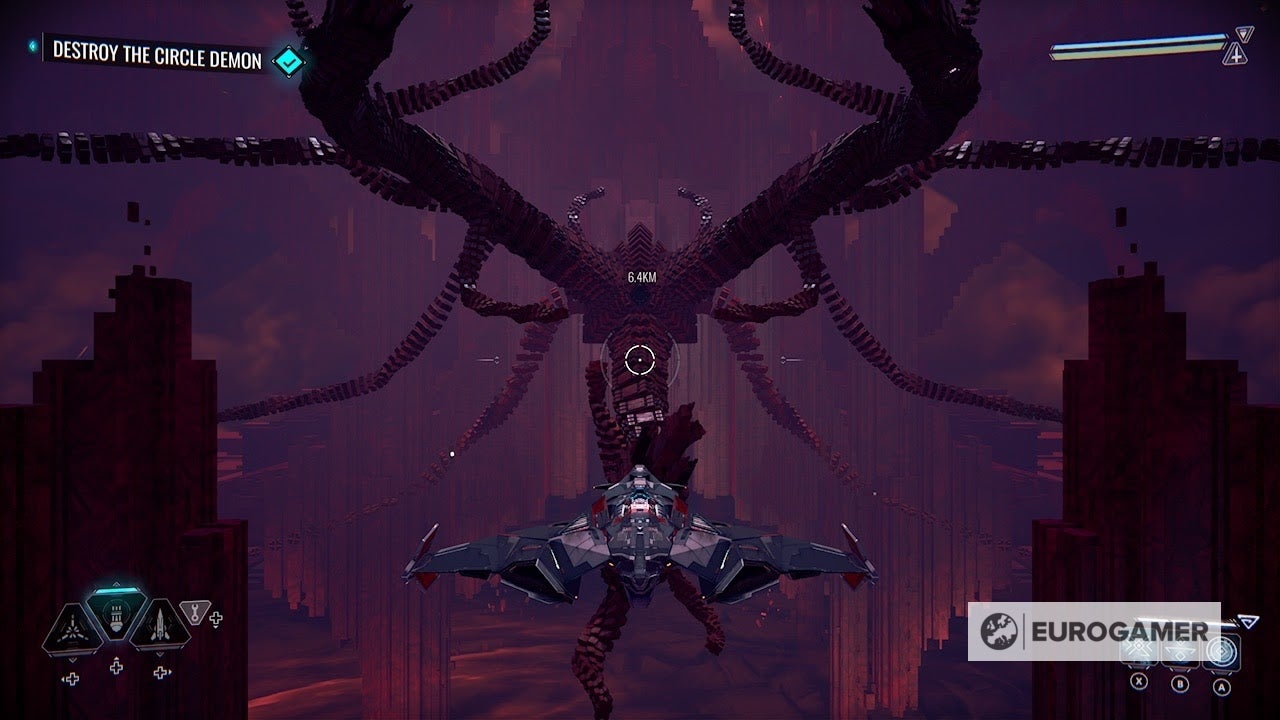Chorus’ combat is the highlight. It’s what you’ll be waiting to get back to when the game gives you literally anything else. Swerving past enemy ships, tailing them and eventually blowing them up is always a thrill, even though it’s nothing original, and the speed and fluidity of Chorus’ movements are enough to keep it fun. The game does also throw its own innovations into the space combat formula. Your ship comes with three different weapons with their own uses and downsides. The gatling guns are your classic high rate-of-fire machinery - they’re easy to aim but do relatively low damage, so they’re best at dealing with canon fodder enemies. The lasers are mainly used to burn through enemy shields making them vulnerable to a full takedown. And then there’s the missile launcher that you’ll need to make use of against armoured targets. It’s not the most strategic system but switching between the three keeps the momentum high and adds variety to the combat. Protagonist Nara has abilities, called Rites, that make things a lot more fun. Throughout her adventure, Nara works to reawaken several of her lost abilities. At first this is limited to the Rite of the Senses, which is your standard Eagle Vision ability, highlighting enemies, objectives, collectibles and so on but, while the Rites begin in mundane fashion, eventually Nara becomes a beast on the battlefield, flinging ships into each other, zipping through them, or teleporting behind them in the perfect position for a kill. Chorvs’… I mean Chorus’ massive space battles do a lot of heavy lifting. There’ll usually be two or three different factions and several enemy types in the area, while the main enemy fleet ship is the responsibility of Nara. Blowing up the ship’s batteries, infiltrating its shields and destroying it from the inside is a real Star Wars moment, and there are several of these. It’s where Chorus is at its best: couple the unique abilities and fluid controls with that grand sense of scale and it turns from a fairly run-of-the-mil space combat game into a frantic action experience. If the developer Fishlabs and Deep Silver’s aim was to make a genuinely cinematic space combat game, they succeeded. Play a few dogfights and you’ll be hungry for more. But the game does love to make you wait for more. Chorus could have been a fun, exciting, pretty romp about shooting ships with the occasional cutscene thrown in between for context. Instead Chorus is a fun game about shooting ships… but you need to take 10-minute breaks between the dog fights to participate in the nonsense action-adventure filler. It might sound silly, but any time I wasn’t shooting things in Chorus, I was reminded of the Mean Girls scene where a school girl says: “One time I saw Cady Heron wearing army pants and flip-flops, so I bought army pants and flip-flops.” The impression Chorus gives in these in-between moments is that it heard you liked God of War, or Red Dead Redemption - or any popular action-adventure game - and wanted to try its hardest to fit the big staples of that genre into a space combat game. I don’t want to be too discouraging. Of course, a strong narrative can be told in this genre, and of course an open-world could be interesting too. But in Chorus, they sadly aren’t. The story begins with a lengthy cutscene full of exposition, backstory and a bunch of words that’ll be foreign to anyone that hasn’t done their research. It describes Nara’s past as a powerful and murderous agent of The Circle, the evil cult that wants to rule the world to bring the everlasting peace, called Chorus. Despite all the eye-catching imagery and high sci-fi concepts, the opening fails to give you a reason to care. There’s nothing mysterious or enticing or emotional about the setup and this lack of substance continues throughout. Let’s take Nara’s relationship with her ship as an example. The ship’s name is Forsa, short for Forsaken. He’s sentient and we find out Nara’s had him locked up for the past seven years. Nara brings him out of captivity early on in the game and he’s rightfully angry about being left behind in some dark temple until the moment Nara needed him again. This conflict is resolved quickly as Nara apologises and Forsa forgives her. Problem solved. There’s some tension between them but nothing too complicated until Forsa gets angry at her again in another climactic cutscene, and that too is quickly resolved and forgotten about. It’s somehow climatic and anti-climactic at the same time, like all of the game’s emotional moments come from nowhere and disappear without a trace. That uneven tone can be especially grating when it’s combined with the lack of levity. I’m not expecting Marvel quips every five minutes, but when the character’s stress level is always a ten, it lessens the impact those tenser moments do have. The open-world hubs have similar problems with a lack of impact. There are side-quests, some of them are fun, some of them are usual escort or delivery missions. There’s loot you can use to upgrade your stats. And there’s random encounters that’ll give you some of that sweet, sweet action you’ve been craving. But the problem with the open environments is how long it can take to traverse and get to the next mission. It’s essentially an excuse to funnel forgettable dialogue at you for six minutes while you do nothing but hold the boost button and watch the kilometers go down. Chorus’ story isn’t the worst thing I’ve seen in a video game, of course - it’s far from that. But the frequency at which it interrupts your playtime with largely forgettable filler makes playing it slightly annoying - all the more so when, beyond the lifeless narrative and long stretches of traversal, Chorus’ combat offers more than enough to hook you on its own.


